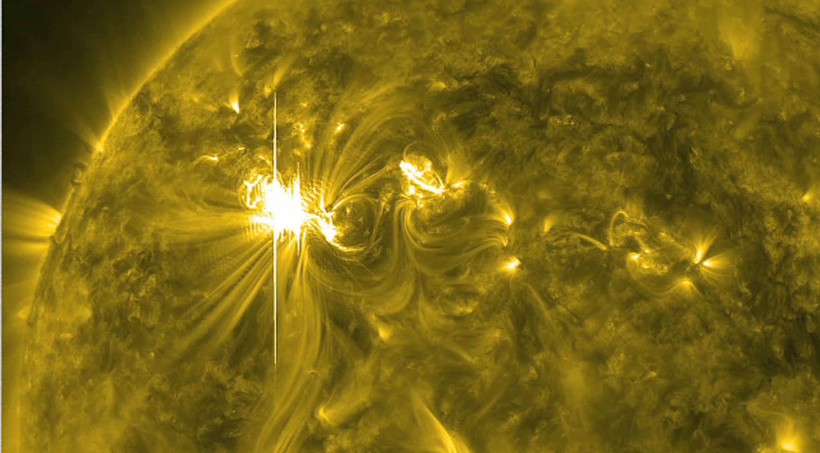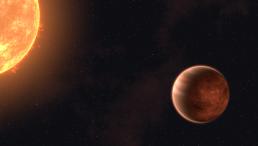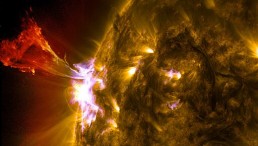Scientists have come up with a new, unified hypothesis for why the sun is hot - or, more precisely, why the upper atmosphere of our star is so heated when it's farthest from the core.
The new idea might aid scientists to better understand solar wind, which is composed of charged particles that stream from the sun's upper atmosphere and can interfere with satellites and transfer energy into the Earth's magnetic field.
Scientists from the University of Otago offer a novel method for solving the solar astronomy problem in new research titled "High-frequency heating of the solar wind triggered by low-frequency turbulence," published in the journal Nature Astronomy Thursday.

In this handout from NASA/Solar Dynamics Observatory (SDO), a X5.4 solar flare, the largest in five years, erupts from the sun's surface March 6, 2012.
Researchers Explain Why Sun's Upper Atmosphere Is Much Hotter Than Its Surface
Astrophysicists have reconciled two key hypotheses explaining the stellar corona's tremendous heat, demonstrating that they correspond to NASA's Parker Solar Probe measurements.
Researchers examined how particles are heated and interact with the gigantic furnace's magnetic fields using a six-dimensional simulation of a tiny portion of the sun's corona — the outermost part of the sun's atmosphere that is usually hidden by the bright light of its surface.
Jonathan Squire, an astrophysicist from the University of Otago in New Zealand, said in a CNet report that the results connected two earlier hypotheses that had each been thoroughly investigated.
The ideas concentrate on "turbulence," which warms the corona by moving energy from the sun's surface outward, and "ion cyclotron waves," a magnetic wave.
Both hypotheses have flaws that do not match findings from satellites and telescopes. Hence, researchers are stumped on how the corona can grow that hot on its own.
There might be numerous distinct mechanisms acting in various sections of the sun, Squire said. He added that separate systems could be heating the corona in different ways.
While all of this may appear to be an issue that exists 100 million miles away, the corona and the solar wind that erupts from the sun may cause havoc on Earth.
ALSO READ: What Are The Weird Waves Inside the Sun That Defy Physics? Scientists Explain Mystery
Researchers said these factors fire particles into space, causing geomagnetic storms, damaging satellites, and tampering with our planet's magnetic field.
According to Squire, the reason such storms are so powerful has to do with how the corona and solar wind heat up.
Indirectly, turbulence and ion cyclotron waves may one day disable your internet - unless we can predict when they will occur.
How NASA Parker Probe Helped Astronomers Solve Mystery
In 2018, NASA Parker Probe set off on a mission to the sun.
With each planet rotation, the probe exploited Venus' gravity to drive itself closer and closer to the Sun.
The Parker Probe came within over 5 million miles of the Sun's surface on the most recent orbit. A probe's closest distance has ever reached by a significant margin.
According to The Sun, the probe passed into the coronal layer, which is 100 times hotter than our star's surface.
The probe sent data back to Earth-bound scientists on the discovered segment of the coronal layer. However, it took a few months for the information to traverse 93 million miles.
Research co-author Dr. Romain Meyrand said scientists would be able to better comprehend and anticipate space weather phenomena that might harm spacecraft near Earth beyond getting a better grasp of solar coronal physics for its own purpose.
The dynamics of the solar corona can have a significant influence on Earth, Meyrand said in a statement.
Researchers may be able to construct better models to anticipate future space weather with a better knowledge of its underlying physics, permitting the application of defensive techniques that might prevent - literally - billions of dollars in harm.
RELATED ARTICLE: Geomagnetic Storm Warning: Power Grids, Communications To Be Affected Again As Earth Will Have A Third Near-Miss Solar Flare
Check out more news and information on Space in Science Times.













!['Cosmic Glitch' in Einstein's Theory of General Relativity Could Be Explained in This New Scientific Tweak [Study]](https://1721181113.rsc.cdn77.org/data/thumbs/full/53435/258/146/50/40/cosmic-glitch-in-einsteins-theory-of-general-relativity-could-be-explained-in-this-new-scientific-tweak-study.jpeg)
